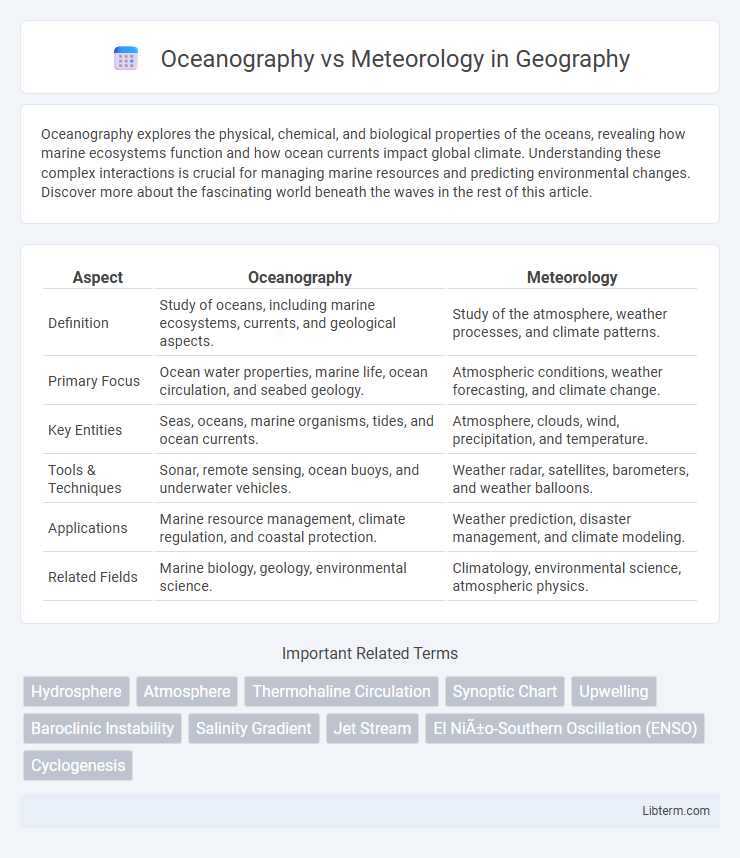Oceanography explores the physical, chemical, and biological properties of the oceans, revealing how marine ecosystems function and how ocean currents impact global climate. Understanding these complex interactions is crucial for managing marine resources and predicting environmental changes. Discover more about the fascinating world beneath the waves in the rest of this article.
Table of Comparison
| Aspect | Oceanography | Meteorology |
|---|---|---|
| Definition | Study of oceans, including marine ecosystems, currents, and geological aspects. | Study of the atmosphere, weather processes, and climate patterns. |
| Primary Focus | Ocean water properties, marine life, ocean circulation, and seabed geology. | Atmospheric conditions, weather forecasting, and climate change. |
| Key Entities | Seas, oceans, marine organisms, tides, and ocean currents. | Atmosphere, clouds, wind, precipitation, and temperature. |
| Tools & Techniques | Sonar, remote sensing, ocean buoys, and underwater vehicles. | Weather radar, satellites, barometers, and weather balloons. |
| Applications | Marine resource management, climate regulation, and coastal protection. | Weather prediction, disaster management, and climate modeling. |
| Related Fields | Marine biology, geology, environmental science. | Climatology, environmental science, atmospheric physics. |
Introduction to Oceanography and Meteorology
Oceanography studies the physical, chemical, and biological properties of oceans, emphasizing marine ecosystems, ocean currents, and sea floor geology. Meteorology focuses on the atmospheric processes that drive weather patterns, climate variations, and atmospheric phenomena. Both sciences use advanced remote sensing and modeling techniques to analyze their respective environments.
Defining Oceanography: Scope and Focus
Oceanography is the scientific study of the physical, chemical, biological, and geological aspects of the world's oceans, encompassing marine ecosystems, ocean currents, and seabed geology. This discipline focuses on understanding the complex interactions between oceanic processes and the earth's climate system, highlighting phenomena such as wave dynamics, ocean circulation, and nutrient cycles. By analyzing these elements, oceanography provides critical insights into marine biodiversity, climate change impacts, and the sustainable management of ocean resources.
Understanding Meteorology: Scope and Focus
Meteorology primarily studies atmospheric phenomena, including weather patterns, climate dynamics, and atmospheric processes influencing daily and long-term weather conditions. Its scope encompasses the analysis of temperature, humidity, wind patterns, and precipitation to forecast weather and understand climate variability. Meteorologists use advanced tools like weather satellites, radar systems, and computer models to predict atmospheric changes and assess impacts on the environment and human activities.
Key Differences Between Oceanography and Meteorology
Oceanography studies the physical, chemical, biological, and geological aspects of the ocean, examining phenomena like ocean currents, marine ecosystems, and seafloor topography. Meteorology focuses on atmospheric processes and weather patterns, analyzing factors such as temperature, humidity, wind, and precipitation. The key differences lie in their primary subjects--oceanography centers on aquatic environments, while meteorology concentrates on atmospheric conditions and weather forecasting.
Interconnectedness of Oceans and Atmosphere
Oceanography and meteorology study the dynamic interactions between the ocean and atmosphere that regulate Earth's climate systems. Ocean currents influence atmospheric pressure patterns, while atmospheric conditions drive oceanic phenomena such as upwelling and El Nino events. Understanding this interconnectedness improves climate prediction models and helps address global challenges like climate change and extreme weather events.
Research Methods in Oceanography and Meteorology
Research methods in oceanography primarily involve the use of remote sensing technologies, autonomous underwater vehicles (AUVs), and in situ water sampling to study marine ecosystems, ocean currents, and chemical properties. Meteorology relies heavily on satellite imagery, weather radar systems, atmospheric sounding, and numerical weather prediction models to analyze atmospheric conditions and forecast weather patterns. Both fields integrate large-scale data assimilation and interdisciplinary approaches to enhance the accuracy of environmental monitoring and predictive capabilities.
Career Paths in Oceanography vs Meteorology
Career paths in oceanography often involve research roles studying marine ecosystems, climate impacts, and ocean circulation, with opportunities in academia, government agencies like NOAA, and environmental consulting firms. Meteorology careers focus on weather forecasting, climate modeling, and atmospheric research, with positions in weather services, aviation, defense, and broadcast media. Both fields demand strong skills in data analysis, modeling, and environmental science, but oceanography emphasizes marine environments while meteorology centers on atmospheric phenomena.
Impact on Climate Studies and Environmental Science
Oceanography provides critical insights into ocean currents, heat distribution, and carbon cycling, which are essential for understanding climate regulation and predicting long-term climate change. Meteorology contributes real-time data on atmospheric conditions, weather patterns, and extreme events that influence short-term climate variability and help model atmospheric interactions. Their combined data integration enhances the accuracy of climate models and informs environmental policies addressing global warming and ecosystem resilience.
Technological Tools Used in Both Fields
Oceanography employs advanced sonar systems, autonomous underwater vehicles (AUVs), and satellite remote sensing to map ocean floors, monitor marine life, and analyze sea surface temperatures. Meteorology utilizes Doppler radar, weather satellites, and numerical weather prediction models to track atmospheric conditions, forecast weather patterns, and study climate phenomena. Both fields rely on GPS technology and data assimilation techniques to enhance accuracy in environmental monitoring and predictive analysis.
Future Trends in Oceanography and Meteorology
Future trends in oceanography emphasize advanced satellite remote sensing, autonomous underwater vehicles, and enhanced climate modeling to better understand ocean-atmosphere interactions and predict sea-level rise. Meteorology increasingly incorporates machine learning algorithms, high-resolution numerical weather prediction models, and integration of big data from satellites and IoT devices to improve forecasting accuracy and severe weather early warning systems. Both fields prioritize interdisciplinary collaboration and real-time data assimilation to address climate change impacts and support sustainable environmental management.
Oceanography Infographic

 libterm.com
libterm.com